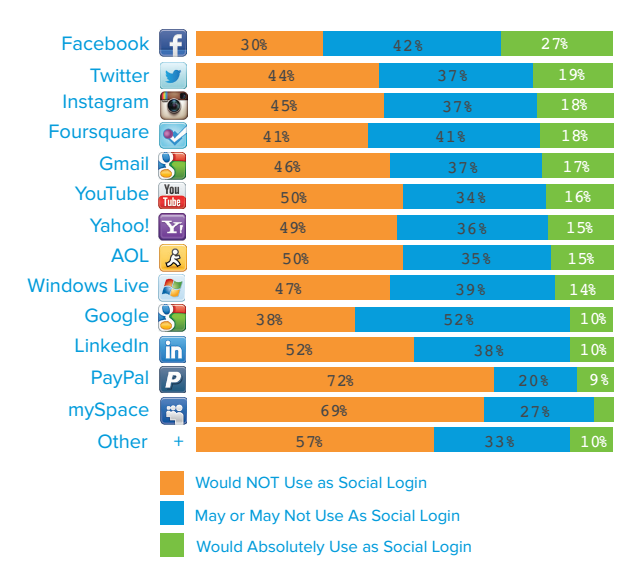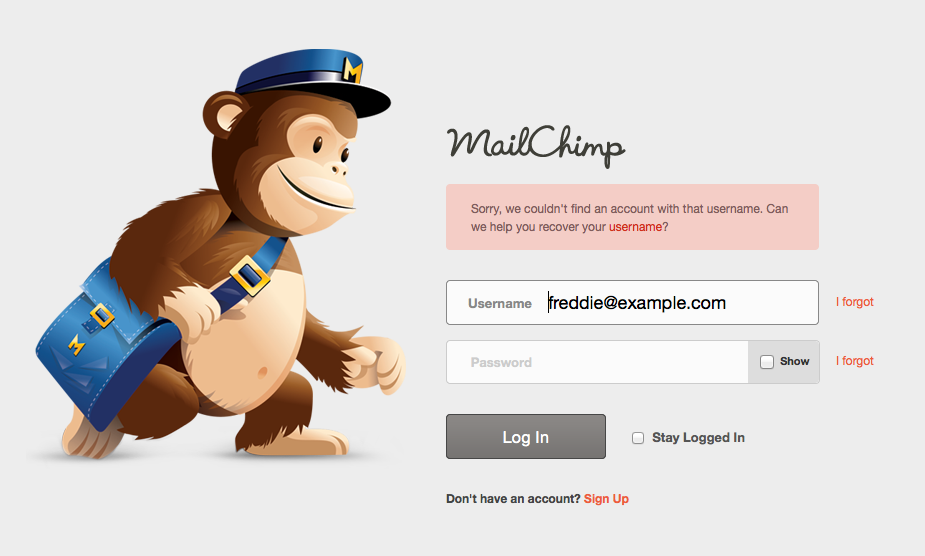Will the login through a social media account replace the usual login form?
Logging into the site through an account has always been a problem for most users. Creating the next account, the user always encounters a bunch of obstacles that often become insurmountable. Is it worth it to indicate your main mail or use mail for spam, is there a simple password enough or a password that meets specific requirements, how on the next visit to remember exactly what data was indicated on this particular site?
Often, to solve this problem, a controversial element of site functionality is used - login through social networks. Somewhere on Habr even something like “It infuriates me that website developers are sure that everyone has an account on Facebook and sometimes make login through social networks the only possible way.”
But let's turn to statistics from foreign Internet (data from http://janrain.com/ ):
1. To begin with, 87% of respondents have an account on social networks. It is worth remembering that the study was conducted among active Internet users, which almost completely excludes the part of the population that goes online once a week to see the weather.
In this case, only 18% of the owners of pages in social networks do not use the registration form through social. networks on third-party resources. As a result, it turns out that 71% of users consider using your account on Facebook and others like it an acceptable way to enter the site.
2. 64% of respondents abandoned attempts to get to the site one or more times because they forgot the username or password of their account, and the reluctance to spend time and energy on their recovery exceeded the need for information that they tried to access.
3. 65% say they’re more likely to return to the site, which provides the opportunity to enter through the social. network.
4. 67% consider this way of entry a great way to personalize the content of the site.
5. 60% think that companies that use logins through social accounts are more trustworthy and also look modern and advanced.
6. Not all accounts use with the same zeal:

But everything is not so rosy, the story is from MailChimp. ”

In 2012, MailChimp experts determined that about 100,000 users left the site without having to fill out the login form, forgetting their username, password, or all at once. Another solution was to add the ability to use an account on social networks to enter the site. The result was a 71% reduction in the number of failed login attempts, and the frequency of the password recovery procedure decreased by 42%.
The experience of MailChimp has shown that often, entering a site turns into a guessing game. The user changes the components of the login / password combination, trying to choose the optimal one. In addition, most users have several options for such combinations, which greatly complicates the process. Five pairs - these are 25 options that need to be sorted out, while users resort to the password recovery function extremely rarely.
But further research showed that only 3.4% of users took advantage of the new feature. In addition, the CEO said that it seems to him that the new elements clutter up the page and now it does not look respectable.
The disadvantages of this method of authorization
The accounting information, in fact, belongs to a third party. Who and how can use this information? What happens if a third party ceases to exist? Who guarantees the safety of this data? May dissolve at any time, out of your control.
In addition, situations are possible that will significantly reduce the level of confidence in the security of a particular social network, which will entail extrapolating the negative opinions of users to a resource that uses this network to enter.
What can you do to make life easier for the user?
Returning to the history of MailChimp. You already understood that the new login features did not bring any results; in fact, changes in the bug tracking policy and more informative messages led to improvements. Instead of a lengthy statement that the user entered the wrong data, the site visitor received accurate information about what part of the credentials was entered incorrectly.

Conclusion
Input through social networks, so far, is not able to replace the usual form of entry or its analogues. When deciding on the design of the login page, it is important to consider the specifics of your resource. If the start page of an entertainment or training site may well contain such functionality, then on a resource that has high requirements for confidentiality and data security, they look absolutely inappropriate.
The only area where social media entry can rule almost undividedly is the mobile Internet. Here the advantages of the functionality and the absence of the need to go through the painful procedure of entering data from the keyboard gives such a method of transferring credentials indisputable advantages.
Often, to solve this problem, a controversial element of site functionality is used - login through social networks. Somewhere on Habr even something like “It infuriates me that website developers are sure that everyone has an account on Facebook and sometimes make login through social networks the only possible way.”
But let's turn to statistics from foreign Internet (data from http://janrain.com/ ):
1. To begin with, 87% of respondents have an account on social networks. It is worth remembering that the study was conducted among active Internet users, which almost completely excludes the part of the population that goes online once a week to see the weather.
In this case, only 18% of the owners of pages in social networks do not use the registration form through social. networks on third-party resources. As a result, it turns out that 71% of users consider using your account on Facebook and others like it an acceptable way to enter the site.
2. 64% of respondents abandoned attempts to get to the site one or more times because they forgot the username or password of their account, and the reluctance to spend time and energy on their recovery exceeded the need for information that they tried to access.
3. 65% say they’re more likely to return to the site, which provides the opportunity to enter through the social. network.
4. 67% consider this way of entry a great way to personalize the content of the site.
5. 60% think that companies that use logins through social accounts are more trustworthy and also look modern and advanced.
6. Not all accounts use with the same zeal:
But everything is not so rosy, the story is from MailChimp. ”

In 2012, MailChimp experts determined that about 100,000 users left the site without having to fill out the login form, forgetting their username, password, or all at once. Another solution was to add the ability to use an account on social networks to enter the site. The result was a 71% reduction in the number of failed login attempts, and the frequency of the password recovery procedure decreased by 42%.
The experience of MailChimp has shown that often, entering a site turns into a guessing game. The user changes the components of the login / password combination, trying to choose the optimal one. In addition, most users have several options for such combinations, which greatly complicates the process. Five pairs - these are 25 options that need to be sorted out, while users resort to the password recovery function extremely rarely.
But further research showed that only 3.4% of users took advantage of the new feature. In addition, the CEO said that it seems to him that the new elements clutter up the page and now it does not look respectable.
The disadvantages of this method of authorization
The accounting information, in fact, belongs to a third party. Who and how can use this information? What happens if a third party ceases to exist? Who guarantees the safety of this data? May dissolve at any time, out of your control.
In addition, situations are possible that will significantly reduce the level of confidence in the security of a particular social network, which will entail extrapolating the negative opinions of users to a resource that uses this network to enter.
What can you do to make life easier for the user?
Returning to the history of MailChimp. You already understood that the new login features did not bring any results; in fact, changes in the bug tracking policy and more informative messages led to improvements. Instead of a lengthy statement that the user entered the wrong data, the site visitor received accurate information about what part of the credentials was entered incorrectly.

Conclusion
Input through social networks, so far, is not able to replace the usual form of entry or its analogues. When deciding on the design of the login page, it is important to consider the specifics of your resource. If the start page of an entertainment or training site may well contain such functionality, then on a resource that has high requirements for confidentiality and data security, they look absolutely inappropriate.
The only area where social media entry can rule almost undividedly is the mobile Internet. Here the advantages of the functionality and the absence of the need to go through the painful procedure of entering data from the keyboard gives such a method of transferring credentials indisputable advantages.
